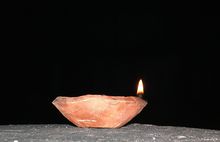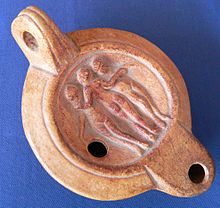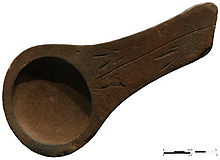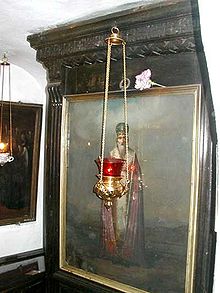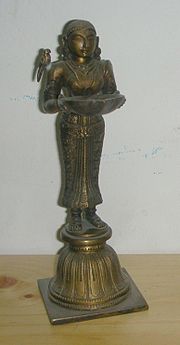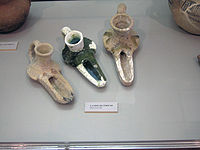- Oil lamp
-
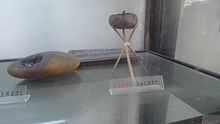 Neolithic stone lamps in Thousand Lamp Museum in Qiandeng town of Kunshan
Neolithic stone lamps in Thousand Lamp Museum in Qiandeng town of Kunshan Traditional Indian earthenware oil lamp or diya
Traditional Indian earthenware oil lamp or diya
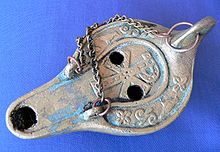 Antique bronze oil lamp with the "Chi Rho", a Christian symbol (replica)
Antique bronze oil lamp with the "Chi Rho", a Christian symbol (replica) Simple contemporary Indian clay oil lamp during diwali
Simple contemporary Indian clay oil lamp during diwali
An oil lamp is an object used to produce light continuously for a period of time using an oil-based fuel source. The use of oil lamps began thousands of years ago and is continued to this day.
Oil lamps are a form of lighting, and were used as an alternative to candles before the use of electric lights. Starting in 1780 the Argand lamp quickly replaced other oil lamps still in their basic ancient form. These were, in turn, replaced by the kerosene lamp in about 1850. In small towns and rural areas these continued in use well into the 20th century, until such areas were finally electrified, and light bulbs could be used for lighting.
Most modern lamps (such as lanterns) have been replaced with gas-based or petroleum-based fuels as they are safer to operate when emergency non-electric light is required. As such, oil lamps of today are primarily used for the particular ambiance they produce, or in rituals and religious ceremonies.
Contents
Structure and function
Oil lamps were used not only for household lighting, but also for funerary and votive purposes. Lamps were used for domestic purposes in homes and for public purposes in temples and most public buildings.
By studying the lamp's designs, symbols, structure and decorations, and the material of which it is made, we can identify the age and perhaps the locality of the lamp. The lamp can also give us insights into the culture of its users and their social status.
Occasionally the design of the lamps also reveal the female reproductive system. Indian bronze lamps with a protruding central portion are supposed to project the male genitalia on a female womb with light representing 'origin of life' in most cases.
Components
 Double-nozzled oil lamp found in Samaria
Double-nozzled oil lamp found in Samaria
The following are the main external parts of a terra-cotta lamp.
- Shoulder
- Pouring hole
- The hole through which fuel is put inside the fuel chamber. The width ranges from 0.5-5 cm in general. There may be single or multiple holes.
- Pick hole, and the nozzle.
- It may be just an opening in the body of the lamp, or an elongated nozzle. In some specific types of lamps there is a groove on the superior aspect of the nozzle that runs to the pouring hole to collect back the oozing oil from the wick.
- Handle
- Lamps come with and without a handle. The handle comes in different shapes. The most common is ring shaped for the forefinger surmounted by a palmette on which the thumb is pressed to stabilize the lamp. Other handles are crescent shaped, triangular and semi-oval. The handleless lamps usually have an elongated nozzle, and sometimes have a lug rising diagonally from the periphery. The lug may act as a small handle where the thumb rests. Some lugs are pierced. It was speculated that pierced lugs were used to place a pen or straw, called the acus or festuca, with which the wick was trimmed. Others think that the pierced lugs were used to hang the lamp with a metal hook when not in use.
- Discus
- Volute
- Fuel chamber
- The fuel reservoir. The mean volume in a typical terra-cotta lamp is 20 cc.
Wicks
A wick is placed over the nozzle and extends into the fuel chamber. Most lamps come with one nozzle; a few lamps have more, from two to twenty nozzles. However, the more nozzles, the greater the fuel consumption.
The wick was made of different materials, linen, flax, papyrus, tow, or ordinary rush. The thickness of the wick is an important factor too; thin wicks burn fuel more slowly than thick ones. However, the thickness of the wick does not have much effect on the size of the flame.[citation needed]
Fuel
Fuels used for oil lamps depend on such variables as the location, time period and perhaps the reason for the lamp's use; ceremonial use of lamps for instance may require a particular oil or fragrance to be used. The main fuel in Western nations was olive oil in ancient Mediterranean cultures, though extracts from fish, crude fish oil, nuts, and cheese were also used. In much later times whale oil was favoured for its cleaner burning flame. Oozing crude petroleum was also used.[1] The fuel was poured into the fuel reservoir via the pouring hole in the discus.
Castor oil was used by the ancient Egyptians. In Africa, carrot oil, peanut oil, mustard oil and nettle oil are used. Indian lamps, especially for use in puja, almost exclusively use ghee as fuel.
Among other fuels used have been coal oil and paraffin/kerosene in paraffin lamps (also called kerosene lamps and coal oil lamps). Oil lamps can use many other fuels including jathropa seed oil and biodiesel along with wvo, soybean oil, canola oil, hemp seed oil, sunflower seed oil, and olive oil.
Lamps were usually put in lamp holders when in use, partly to avoid the risk of fire. They might be fastened to a wall by a nail or a wooden wedge, hung suspended from brackets, placed in a candelabra, placed in niches in the wall, put on lamp stands of different shapes, or carved as part of stone lamp pillars.
Production methods
Before the invention of the wheel in the Middle Bronze Age, lamps were made by hand. An early form of the potter’s wheel was invented and introduced in the Middle Bronze Age and used to manufacture lamps until around the 3rd century BCE. The use of molds was first developed in Greece and Egypt during the 3rd century BCE. In Roman times, stone, clay, or plaster molds were utilized on a large scale across the Roman Empire until around the 8th century CE.
To make a lamp, two molds are needed: one for the upper part and one for the lower part. Some pairs of molds have knobs and corresponding holes to fit the two molds together. In order to create the mold, an archetype or patrix is first made. Plaster or clay is then formed around the patrix, which dries and hardens into a mold. Clay molds are removed from the patrix before they are fully dried. They are then kiln fired, thus they may deviate or shrink from their original form. Clay molds need more labor than plaster ones. However, clay molds are more durable. Plaster molds are dried completely and then removed from the patrix. Plaster thus makes an accurate replica, but it has the disadvantage of leaving some surface granular artifacts. Due to the perishable nature of plaster, it has proven difficult to find remains of ancient plaster molds. Several clay molds, however, have been recovered. By studying the surfaces of surviving lamps it seems that plaster was preferred to clay.
Lamp typology
Lamps can be categorized based on different criteria, including material (Clay, Silver, Bronze, Gold, Stone, slip), shape, structure, design, and imagery (e.g. symbolic, religious, mythological, erotic, battles, hunting).
Lamp typological categories
Typologically, lamps of the Ancient Mediterranean can be divided into six major categories
Wheel made: This category includes Greek and Egyptian lamps that date before the 3rd century BCE. They are characterized by simple, little or no decoration, and a wide pour hole, a lack of handles, and a pierced or unpierced lug. Pierced lugs occurred briefly between 4th and 3rd century BCE. Unpierced lugs continued until 1st century BCE.
Volute, Early Imperial: With volutes extending from their nozzles, these lamps were predominately produced in Italy during the Early Roman period. They have a wide discus, a narrow shoulder and no handle, elaborate imagery and artistic finishing, and a wide range of patterns of decoration.
High Imperial: These are late Roman. The shoulder is wider and the discus is smaller with fewer decorations. These lamps have handles and short plain nozzles, and less artistic finishing.
Frog: This is a regional style lamp exclusively produced in Egypt and found in the regions around it, between ca. 100 – 300 CE. The frog, (Heqet), is an Egyptian fertility symbol.
African Red Slip lamps were made in North Africa, but widely exported, and decorated in a red slip. They date to the second century CE and comprise a wide variety of shapes including a flat, heavily decorated shoulder with a small and relatively shallow discus. Their decoration is either non-religious, Christian or Jewish. Grooves run from the nozzle back to the pouring hole and it is hypothesized that this is to take back spilled oil. These lamps often have more than one pour-hole.
Slipper lamps are oval shaped and found mainly in the Levant. They were produced between the 3rd to 9th century CE. Decorations include vine scrolls, palm wreaths, and Greek letters.
Factory lamps: Also called Firmalampen (from German), these are universal in distribution and simple in appearance. They have a channeled nozzle, plain discus, and 2 or 3 bumps on the shoulder. Initially made in factories in Northern Italy and Southern Gaul between 1st century and 3rd centuries CE, they were exported to all Roman provinces. The vast majority have been stamped to identify the manufacturer.
Oil lamps in religious contexts
Roman Neopaganism
In the Religio Romana, which is the modern reconstruction of the religion of Ancient Rome, an oil lamp is placed on the lararium and lit before prayers are said. The lamp symbolizes Vesta, as well as the protective power she offers to a home.
Judaism
Lamps appear in the Torah and other Jewish sources as a symbol of “lighting” the way for the righteous, the wise, and for love and other positive values. While fire was often described as being destructive, light was given a positive spiritual meaning. The oil lamp and its light were important household items, and this may explain their symbolism. Oil lamps were used for many spiritual rituals. The oil lamp and its light also became important ritualistic articles with the further development of Jewish culture and its religion.
- “And you shall command the people of Israel that they bring to you pure beaten olive-oil for the light, that a lamp may be set to burn continually”. Exodus 27:20
- “When you set the lamps, the seven lamps shall give light in front of the lamp stand (menorah).” Numbers 8: 1 -4
- “There I shall cause pride to sprout for David; I have prepared a lamp for my anointed.” (Psalms 132:16);
- “For a commandment is a lamp and the Torah is light; and reproving discipline is the way of life.” (Proverbs 6:23);
- “A man’s soul is the lamp of God, which searches the chambers of one’s innards.” (Proverbs 20:27).
- “A lamp is called a lamp, and the soul of man is called a lamp.” (Babylonian Talmud, Shabbat 30B)
Chanukah
The Temple Menorah, a ritual seven branched oil lamp used in the Second Temple, forms the centre of the Chanukah story and centers on the miracle that during the cleansing of the Jewish temple in Jerusalem after its looting, the lamp was supposed to burn continuously, forever, but there was only oil enough for one day, and no more oil would be available for 8 days; miraculously the oil expected to last for only one day instead burnt for 8 full days.
Christianity
There are several references to oil lamps in the New Testament:
- “Your eye is the lamp of your body; when your eye is sound, your whole body is sound, your whole body is full of light; but when it is not sound, your body is full of darkness.” (Luke 11:34);
- “He was a burning and shining lamp, and you were willing to rejoice for a while in his light.” (John 5:35);
- “And night shall be no more; they need no light of lamp or sun, for the Lord God will be their light, and they shall reign for ever and ever.” (Rev 22:5).
In the Orthodox Church and many Eastern Catholic Churches oil lamps (Greek: kandili, Slavonic: lampada) are still used both on the Holy Table (altar) and to illuminate icons on the iconostasis and around the temple (church building). Orthodox Christians will also use oil lamps in their homes to illuminate their icon corner.
Traditionally, the sanctuary lamp in an Orthodox church is an oil lamp. It is lit by the bishop when the church is consecrated, and ideally it should burn perpetually thereafter. The oil burned in all of these lamps is traditionally olive oil.
In Greece and Cyprus, lampáda (Greek: λαμπάδα) is the special name for the candle held by the faithful on the Easter service celebrating the Resurrection. Although any regular paraffin or beeswax candle can be used, a lampáda is usually a large, white candle or, in the case of children, a multicolored candle decorated with ribbons, beads, toys, dried flowers etc. The lampáda is lit at midnight, with the holy light from the priest's candle, and then carried home. The sign of the cross is often made with soot from this flame on the lintel above the home's main door, and the flame is transferred to the icon corner oil lamp; only then can the lampáda be extinguished. The cross over the door and the flame before the icons are believed to confer the Risen Lord's protection on the household.
Islam
"God is the Light of the heavens and the earth. The parable of His light is, as it were, that of a niche containing a lamp; the lamp is [enclosed] in glass, the glass [shining] like a radiant star: [a lamp] lit from a blessed tree - an olive-tree that is neither of the east nor of the west the oil whereof [is so bright that it] would well-nigh give light [of itself] even though fire had not touched it: light upon light! God guides unto His light him that wills [to be guided]; and [to this end] God propounds parables unto men, since God [alone] has full knowledge of all things". 24:35
Hinduism
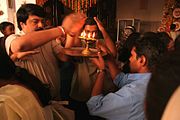 Blessing at a Durga puja celebration
Blessing at a Durga puja celebration A Deepalakshmi oil lamp from Kumbakonam
A Deepalakshmi oil lamp from Kumbakonam
Oil lamps are commonly used in Hindu temples as well as in home shrines. Generally the lamps used in temples are circular with places for five wicks. They are made of metal and either suspended on a chain or screwed onto a pedestal. There will usually be at least one lamp in each shrine, and the main shrine may contain several. Usually only one wick is lit, with all five burning only on festive occasions. The oil lamp is used in the Hindu ritual of Aarti.
In the home shrine, the style of lamp is usually different, containing only one wick. There is usually a piece of metal that forms the back of the lamp, which has a picture of a Hindu deity embossed on it. In many houses, the lamp burns all day, but in other homes, it is lit at sundown. The lamp in the home shrine is supposed to be lit before any other lights are turned on at night.
A hand-held oil lamp or incense sticks (lit from the lamp) are also used during the Hindu puja ceremony. In the North of India, a five-wick lamp is used, usually fueled with ghee. On special occasions, various other lamps may be used for puja, the most elaborate having several tiers of wicks.
In South India, there are a few types of oil lamps that are common in temples and traditional rituals, some of the smaller ones are used for offerings as well:
- Deepalakshmi, a brass lamp with a depiction of goddess Sri Lakshmi over the back piece. they are usually small-size and have only one wick.
- Nilavilakku, a tall brass or bronze lamp on a stand where the wicks are placed at a certain height.
- Paavai vilakku, a brass or bronze lamp in the form of a lady holding a vessel with her hands. This type of lamp comes in different sizes, from very small to almost life-size. There are also large stone versions of this lamp in Hindu temples and shrines of Tamil Nadu and Kerala, especially at the base of columns and flanking the entrance of temples. They have only one wick.
- Thooku vilakku, a brass or bronze lamp hanging from a chain, often with multiple wicks.
Chinese folk religion
Oil lamps are lit at traditional Chinese shrines before either an image of a deity or a plaque with Classical Chinese characters giving the name of the deity. Such lamps are usually made from clear glass (they look similar to normal drinking glasses) and are filled with oil, sometimes with water underneath. A cork or plastic floater containing a wick is placed on top of the oil with the bottom of the wick submerged in the oil.
Such lamps are kept burning in shrines, whether private or public, and incense sticks or joss sticks are lit from the lamp.
Archaeological chronology
It is very difficult to say when and where the first oil lamp was used. This is partly because it is difficult to draw a line detailing when the primitive forms of creating a continuous source of light from fire can be termed a lamp. The first lamps were made of naturally occurring objects, coconuts, sea shells, egg shells and hollow stones. Some believe that the first proper lamps were carved from stones. Curved stone lamps were found in places dated to the 10th millennium BCE. (Mesolithic, Middle Stone Age Period, circa 10,300 - 8000 BCE)
Some Archaeologists claim that the first shell-lamps were in existence more than 6,000 years ago. (Neolithic, Later Stone Age, c. 8500 - 4500 BCE). They believe that the alabaster shell-shaped lamps dug up in Sumerian sites dating 2,600 BCE were imitations of real shell-lamps that were used for a long time. (Early Bronze, Canaanite / Bronze I-IV, c.3300 - 2000 BCE)
It is generally agreed that the evolution of handmade lamps moved from bowl-shaped to saucer-shaped, then from saucer with a nozzle, to a closed bowl with a spout.
Chalcolithic Age, c.4500 - 3300 BCE.
The first manufactured red pottery oil lamps appeared. These were of the round bowl type.
The Bronze Ages (3200-1200 BCE)
Lamps were simple wheel-made bowls with a slight pinch on four sides for the wick. Later lamps had only one pinch. These lamps vary in the shape of the rim, the general shape of the bowl and the shape of the base.
- Intermediate Bronze Age lamps (EBIV/MBI)
The earliest lamps known from Intermediate Bronze Age lamps (EBIV/MBI) With the four wick lamps. These lamps are made from large bowls with four shallow pinches for wicks.
- Middle Bronze Age lamps (MB)
The four-wick oil lamps persist into this period, most of the lamps now have one wick. Early in this period the pinch is shallow, while later on it becomes more prominent and the mouth protrudes from the lamp's body. The bases are simple and flat. The crude potter’s wheel is introduced, transforming the handmade bowls to a more uniform container. The saucer style evolves into a single spout shape.
- Late Bronze Age lamps (LB)
A more pronounced, deeper single spout is developed, and it is almost closed on the sides. The shape is evolving to be more triangular, deeper and larger. All lamps are now wheel-made. The base is simple, usually flat.
The Iron Age (1200-560 BCE)
The rim becomes wider and flatter with a deeper and higher spout. The tip of the spout is more upright in contrast to the rest of the rim.
The lamps are becoming variable in shape and distribution. We still find lamps similar to the Late Bronze period. In addition, other forms evolve, such as small lamps with a flat base and larger lamps with a round base. The later form continues into the Iron Age II.
In the later Iron Age, we encounter variant forms. One common type is small, with a wide rim and a wide base. Another type is a small, shallow bowl with a thick and high discus base.
Persian
These large lamps have thin sides and a deep pinch, which flattens the mouth and makes it protrude outward.
Greek
Lamps are more closed to avoid spilling. They are smaller and more refined. Most are handleless. Some are with a lug, pierced and not pierced. The nozzle is elongated. The rim is folded over to make the nozzle, so it overlaps and is then pinched to make the wick hole.
They are round in shape, wheel-made.
Early Roman
Production of oil-lamps shifted to Italy as the main source of supply. Molds used. All lamps are closed in type. Lamps produced in large scale in factories. The lamp is produced in two parts, the upper part with the spout and the lower part with the fuel chamber. Most are of the characteristic Imperial Type. It was round with nozzles of different forms (volute, semi-volute, U shaped), with a closed body and with a central disk decorated with reliefs and its filling hole.
Late Roman
The High Imperial Type. More decorations. Produced locally or imported in large scale. The multiple-nozzled lamps appear. Different varieties.
In this period we find the frog type lamps. These are kidney or heart shaped or oval. With the motif of a frog or its abstraction, and sometimes with geometrical motifs. They were produced around 100 AD. They are so variant that it is seldom that two identical ones are found.
Byzantine
Slipper shaped. Very decorative. The multiple nozzles continue. Most with handles. Some are complex in external anatomy.
Early Islamic
There is a transition period from Byzantine to Islamic lamps. Lamps of this transition period changed from being decorated with crosses, animals, human likenesses, birds, fish, etc., to being decorated with plain linear, geometric, and raised dot patterns.
The early Islamic lamps are a continuation of Byzantine lamps. Decorations were initially a stylized form of bird, grain, tree, plant or flower. Then they became entirely geometric or linear with raised dots.
The first kerosene lamp was described by al-Razi (Rhazes) in 9th century Baghdad, who referred to it as the "naffatah" in his Kitab al-Asrar (Book of Secrets).[2]
In the transition period some lamps had Arabic writing. Then, writing disappears until the Mamluk period (13th - 15th centuries CE).
Regional variations
Land of Israel
- Jerusalem oil lamp: Characteristic black color of the clay because the clay was burned without oxygen. Usually of high quality.
- Daroma oil lamp:
- Jerash oil lamp:
- Nabatean oil lamp:
- Herodian oil lamp: Considered to be used mainly by Jews. Wheel made, rounded. Nozzle with concave sides. The lamps are usually not decorated. If there is decoration, it tends to be simple. Very common throughout all of Israel, and some lamps have also been found in Jordan. Date from 1st century BCE to the end of the 1st century AC.
- Menorah oil lamp, 7 nozzles: Rare and are associated with Judaism because of the numerical connection with the seven branches or arms of the Menorah.
- Samaritan oil lamp: Characterized by a sealed filling hole, which was to be broken by the buyer. This was probably done to ensure ritual purity. A wider spout, and the concavities flanking the nozzle are almost always emphasized with a ladder pattern band. In general the lamps are uncoated. The decorations are linear and/or geometric.
-
- Type I: A distinct channel running from the pouring-hole to the nozzle, a small knob handle, a ladder pattern around the nozzle and shows no ornamentation on the bottom of the base.
- Type II: Pear-shaped and elongated, lined channel that extends from the filling-hole to the nozzle, continued to be used through to the early Muslim period.
- Candle Stick oil lamp: Menorah design on the nozzle and bunch of grapes on the shoulders.
- Byzantine oil lamp: The upper parts are covered with braided patterns and their handles. All are made of a dark orange-red clay. A rounded bottom with a distinct X or cross appears inside the circled base.
- Early Islamic oil lamp: Large knob handle and the channel above the nozzle are dominant elements. The handle is tongue-shaped. Decoration is rich and elegant. The lower parts are extremely broad and the nozzles are pointed.
Importance of oil lamps in India
In vedic times, fire was kept alive in every household in some form and carried with oneself while migrating to new locations. Later the presence of fire in the household or a religious building was ensured by an oil lamp. Over the years various rituals and customs were woven around an oil lamp.
Deep Daan, the gift of a lamp was and still is believed to be the best daan. During marriages, spinsters of the household stand behind the bride and groom, holding an oil lamp to ward off the evil. The presence of oil lamp is an important aspect of ritual worship (the shodashopachar puja) offered to a deity. Moreover, a day is kept aside for the worship of the lamp in the busy festival calendar, on one amavasya (no moon) day in the month of Shravan. This reverence for the deep is based on the symbolism of the journey from darkness and ignorance to light and the knowledge of the ultimate reality – 'tamaso ma jyotirgamaya!'
The earlier lamps were made out of stone or seashells. The shape was like a circular bowl with a protruding beak. Later they were replaced by earthen and metal lamps. In the epics Ramayana and Mahabharata, there are references of gold and silver lamps as well. The simple shape evolved and the lamps were created in the shapes of the matsya (fish), kurma (boar) and other incarnations of god Vishnu and also in the shape of the many attributes of gods like conch shells, lotuses and so on. The birds like swans, peacocks, parrots and animals like snakes, lions, elephants and horses were also favorites while beautifying a lamp. For lighting multiple lamps, wooden and stone deepastambhas (towers of light) were created. Erecting a deepastambha in front of a temple is still a general practice in western and southern India. For adapting the design to the households and smaller spaces, the deepavriksha (tree of light) was formed. As the name suggests, it is a metal lamp container with aesthetically curvi-linear lines branching out from the base each holding a lamp. The Deepalaxmi is another favorite design where goddess Laxmi holds the lamp in her hands. Kuthuvilakku is another typical lamp traditionally used for house hold purposes in South India.
Oil lamps also became proverbial. For example, a Bradj (pre-Hindi) proverb says, "Chiraag tale andhera", "the [utmost] darkness is under the oil-lamp (chiraag)", meaning that what you seek could be close but unnoticed, in various senses (and indeed, a lamp's container casts shadow)
Books and catalogues
General
- Bailey, D.M. (1975-96). A Catalogue of Lamps in the British Museum. British Museum. ISBN 0-7141-1243-7, ISBN 0-7141-1259-3, ISBN 0-7141-1278-X, ISBN 0-7141-2206-8.. Huge catalogue in four quarto volumes, THE lamp bible but extremely expensive even second-hand. Referred to as BMC.
- Walters, H.B. (1914). Catalogue of the Greek and Roman Lamps in the British Museum. British Museum. Superseded by Bailey but still worthwhile and much cheaper if you can find an old copy.
- Hayes, J.W. (1980.). Ancient Lamps in the Royal Ontario Museum - I: Greek and Roman Clay Lamps. ROM. ISBN 0-88854-253-4. Another superb catalogue and excellent reference, perhaps second only to Bailey
- Djuric, Srdjan (1995). The Anawati Collection Catalog I - Ancient Lamps from the Mediterranean. Eika. ISBN 1-896463-02-9. Less academic than the museum catalogues and short on dating but fairly comprehensive (within its specified area, i.e. not Northern Europe) and extensively illustrated.
- Lyon-Caen; Hoff (1986). Catalogue des Lampes en terre cuite Grecques et Chretiennes. Louvre. ISBN 2-7118-2014-9. In French, good coverage of earlier and later lamps in the Louvre, well illustrated.
- Mlasowsky, Alexander (1993). Die antiken Tonlampen im Kestner-Museum Hannover. Kestner-Museum. ISBN 3-924029-13-X. In German, superb catalogue, profusely illustrated and captioned.
- Robins, F.W. (1970). The Story of the Lamp. Kingsmead. ISBN 0-901571-33-4. Useful introduction but illustrations are very poor and beware as several of the items shown have since been exposed as fakes.
- Bailey, D.M. (1972). Greek and Roman Pottery Lamps. British Museum. ISBN 0-7141-1237-2. Excellent introductory booklet, well illustrated.
- Wetzel, Henning (1997). Antike Tonlampen. Leipzig University. ISBN 3-931922-65-0. In German, small booklet but excellent illustrations in color.
- Skinkel-Taupin, Claire (1980). Lampes en Terre Cuite de la Méditerranée Grecque et Romaine. Brussels. In French, brief guide to a few lamps in the Brussels Museum.
- Clephan, R. Coltman (1907). On Terra-cotta Lamps. Edinburgh. Edwardian illustrated article for the Society of Antiquaries of Scotland, interesting insight into the general knowledge of that time.
Western Europe
- Goethert, Karin (1997). Römische Lampen und Leuchter. Trier: Auswahlkatalog des Rheinischen Landesmuseums Trier. ISBN 3-923319-38-X. In German, emphasis on local lamps found in Trier but excellent coverage of all Roman types of the Rhineland.
- Eckardt, Hella (2002). Illuminating Roman Britain. Montagnac: Editions Monique Mergoil. ISBN 2-907303-70-8. Paperback, frustratingly unindexed but a refreshing approach and well worth plowing through.
- Loeschcke, Siegfried (1919). Lampen aus Vindonissa. Zurich. In German, long out-of-print classic but a superb reference if you can find a copy
- Kirsch, Annette (2002). Antike Lampen im Landesmuseum Mainz. Mainz. ISBN 3-8053-2864-8. In German, catalogue of lamps.
- Chrzanovski, Laurent (2000). Lumieres Antiques: Les lampes à huile du musée romain de Nyon. Edizioni ET. ISBN 88-86752-15-6. Paperback. In French with short summaries in English, Italian and German. Excellent general survey of lamps, detailed study and catalogue of the small collection of Roman oil lamps at Nyon.
Middle (Near) East
- Adler, Noam (2004). A comprehensive catalog of oil lamps of the Holy Land from the Adler collection. Israel: Old City Press. ISBN 965-555-166-0. Comprehensive coverage of lamps from Palestine region.
- Rosenthal, Renate; Sivan, Renée (1978). Qedem 8, Monographs of the Institute of Archaeology, Vol. 8: Ancient Lamps in the Schloessinger Collection. The Hebrew University of Jerusalem. Standard reference.
Aegean
- Broneer, Oscar (1977). Isthmia Volume III: Terracotta Lamps. American School at Athens. Good coverage of local lamps.
- Perlzweig, Judith (1963). Lamps from the Athenian Agora. American School at Athens. Excellent booklet, profusely illustrated and a recommended reference, very cheap used copies.
North Africa
- Herrman, J.L.; van der Hoek, A. (2002). Light from the Age of Augustine. Harvard. Paperback, lavishly color-illustrated guide to North African red slipware including many lamps.
- Fabbricotti, E. (2001). Catalogo delle lucerne di Tolemaide (Cirenaica), BAR International Series 962. Oxford. ISBN 1-84171-182-9. In Italian, detailed catalogue of locally found lamps.
See also
Bibliography
- Amiran Amiran R. Ancient Pottery of the Holy Land, Jerusalem 1969.
- Appolonia-Arsuf 1983 Sussman V. “The Samaritan Oil Lamps from Apolonia-*Arsuf”, TA 10, pp. 71–96.1996 Wexler L. & Gilboa G. “Oil Lamps of the Roman Period from Apollonia-Arsuf”, TA 23, pp. 115–131.
- Bailey Bailey D.M. A Catalogue of the Lamps in the British Museum, III: Roman provincial lamps, London 1988.
- Potok C., 1978. Wanderings, History of the Jews, Ballantine Books
- Ran N., 1987. Journeys to the Promised Land, Terra Sancta Arts
- Rattey B. K., 1964. A Short History of the Hebrews, Oxford Press
- Roth C., 1996. Encyclopaedia Judaica, Keter Publishing
- Runes D., 1959. Dictionary of Judaism, Citadel Press
- Ryan W., Pitman W., 1998. Noha's Flood, Simon and Schuster
- Scheindlin R. P., 1996. The Chronicles of the Jewish People, Michael Friedman Pub.
- Stefoff R., 1997. Finding the Lost Cities, Oxford Press
- Sussman V., 1972. Ornamented Jewish Oil-lamps, Israel Inst. and Exploration Society
- The Grolier, 1994. Encyclopaedia, CD Rom
- The Tanakh, 1985 The Holy Scriptures, Jewish Publication Society
- Uris L., 1998. Jerusalem, Doubleday and Company
- Von Soden W., 1994. The Ancient Orient, William B.Eerdman Publishing.
References
- ^ "[Asphaltos] is found also moyst swimming upon wells in the countries of the Agrigentines of Sicilie, which they use for lamps instead of oyle, and which they call falsely Sicilian oyle, for it is a kinde of moyst Bitumen." Dioscorides (40 A.D.). De Materia Medica. http://www.therenaissanceman.org/images/DIOSCORIDES-Intro_Book_1.doc. Goodyer translation (1655), published by Robert Gunther in 1933.
- ^ Zayn Bilkadi (University of California, Berkeley), "The Oil Weapons", Saudi Aramco World, January–February 1995, p. 20-27.
- Vedagnana.org, Why do Hindus light a lamp ?
External links
- Romulus2.com, ancient Lamps
- Umanitoba.ca,
- Steve-Adler.com, iil Lamps from the Holy land From the Adler collection iil Lamps of Antiquity
- DigCaesarea.org, The Corpus of Terracotta Lamps From Caesarea Maritima Israel (1971–1980)
Lamps and lighting Incandescent Fluorescent High-intensity
discharge (HID)Mercury-vapor · Hydrargyrum medium-arc iodide (HMI) · Hydrargyrum quartz iodide (HQI) · Metal halide (Ceramic) · Sodium vaporGas discharge Deuterium arc · Neon · Sulfur · Xenon arc / Xenon flash · Black light · Tanning lamp · Germicidal · Growth lightElectric arc Combustion Other Lamp (electrical component) · Light fixture · Lightbulb sockets · Light-emitting diode (LED) · LED lamp · Solid-state (SSL) · Plasma · Electroluminescent wire · Chemiluminescence · Radioluminescence · Glow stick · ESL
Wikimedia Foundation. 2010.


